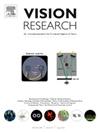诱导知觉分组中的分组策略
IF 1.4
4区 心理学
Q4 NEUROSCIENCES
引用次数: 0
摘要
诱导分组是指感知到的一组元素对另一组元素分组的影响,这种影响无法用其他分组原则来解释。Vickery(2008)首先强调了这一现象,尽管这一原理的论证令人信服,但似乎是唯一的直接研究。在这里,我们报告两个成功的大样本复制维克里的一个实验。我们还用视觉分组和选择的皮质模型来解释维克里的结果。我们扩展了之前的模型,使其对目标图像执行基于特征的搜索。我们表明,诱导分组效应是将视觉搜索任务中的目标对连接在一起的连接策略与倾向于在接近目标对特征的位置放置选择信号的选择策略相结合的结果。这些策略相互作用,因为连接目标对的连接策略有时也连接诱导元件,从而影响信号的选择位置。模型扩展在解释这一现象方面起着关键作用,并使模型能够模拟其他任务,如视觉搜索,其中观察者使用动态和特征引导的选择过程。本文章由计算机程序翻译,如有差异,请以英文原文为准。
Grouping strategies in induced perceptual grouping
Induced grouping refers to the influence of a perceived group of elements on the grouping of another set of elements that cannot be explained by other grouping principles. Vickery (2008) first highlighted this phenomenon and, despite convincing demonstrations of this principle, seems to be the only direct study. Here we report two successful large sample replications of one of Vickery’s experiments. We also explain Vickery’s results with a cortical model of visual grouping and selection. We extended a previous model, so that it performs a feature-based search of an image for a target. We show that induced grouping effects are the result of a connection strategy that links together target pairs in a visual search task combined with a selection strategy that tends to place a selection signal at locations close to the target pair features. These strategies interact because the connection strategy that links target pairs also sometimes links inducing elements, thereby influencing the selection signal location. The model extension plays a key role in explaining this phenomenon and enables the model to simulate other tasks, like visual search, where the observer uses a dynamic and feature-guided selection process.
求助全文
通过发布文献求助,成功后即可免费获取论文全文。
去求助
来源期刊

Vision Research
医学-神经科学
CiteScore
3.70
自引率
16.70%
发文量
111
审稿时长
66 days
期刊介绍:
Vision Research is a journal devoted to the functional aspects of human, vertebrate and invertebrate vision and publishes experimental and observational studies, reviews, and theoretical and computational analyses. Vision Research also publishes clinical studies relevant to normal visual function and basic research relevant to visual dysfunction or its clinical investigation. Functional aspects of vision is interpreted broadly, ranging from molecular and cellular function to perception and behavior. Detailed descriptions are encouraged but enough introductory background should be included for non-specialists. Theoretical and computational papers should give a sense of order to the facts or point to new verifiable observations. Papers dealing with questions in the history of vision science should stress the development of ideas in the field.
 求助内容:
求助内容: 应助结果提醒方式:
应助结果提醒方式:


